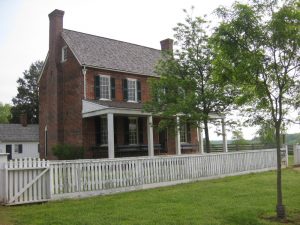On The Eve Of War: Appomattox, Virginia
For an ending to happen, there has to be a beginning. But sometimes the opening moments get over shadowed by the concluding act. That’s certainly what happens with the history surrounding Appomattox Court House, Virginia.
It’s famous as the setting for the most well-known surrender of the Civil War on April 9, 1865, but what was happening just four years earlier? On the eve of war, Appomattox Court House was actually a declining community, but an area of Virginia interested in secession and preparing for a fight before the first shots of the conflict were even fired.

In 1845, Appomattox County had been formed from pieces of Buckingham, Campbell, Charlotte, and Prince Edward counties and took its name from the river in the region. The county seat—originally called “Clover Hill”—was called Appomattox Court House. This small hamlet had a tavern which had serviced travelers on the Richmond-Lynchburg Stage Road. As the new county seat, the area started growing and by the early 1850’s boasted, two stores, several law offices, two taverns, a saddler, wheelwright, a few blacksmith shops, and other community shops. The courthouse area seemed poised for growth, but the arrival of the railroad to the community actually crushed the economy trying to spring up around the judicial building.
A railroad branch from Petersburg extended westward, arriving at Appomattox Depot which was located three miles from Appomattox Court House; then the tracks continued west, never actually reaching the county seat. Many business owners decided to relocate their shops to the depot area. Meanwhile, with the new railroad line running regularly, the stagecoaches stopped journeying, further reducing the traffic through Appomattox Court House. In 1850, the county population totaled 9,193, but ten years later, the 1860 Census recorded a decline to 8,889. In 1860, African Americans totaled 53% of the county’s population—4,600 enslaved and 171 freedmen.
While the population numbers had fallen in the decade leading up the Civil War, the agricultural side of the economy had grown, and the railroad boosted tobacco production and transportation. By 1860, 1,777,355 pounds of tobacco had been grown in a year, nearly doubling from ten years before and adding to local farms’ property values. Many enslaved men, women, and children tended to the tobacco crops.
For the village around the county courthouse, the “first Thursday after the first Monday of each month” was Court Day. Trials drew crowds to witness the jury, lawyers, and accused in the legal proceedings in the brick courthouse. Outside at the same time, auctions and “farmers’ markets” were set up. Here, too, the political aspirants and speechmakers gathered crowds to harangue and inspire about ideas of the day.
The sounds of arguments had grown more intense after 1859, as fear and anger followed John Brown’s Raid at Harpers Ferry. By January 1861, Crawford Jones, a lawyer in Appomattox Court House and delegate in the state assembly, outspokenly supported secession and that month pushed a bill to fund arms and professional training for the Appomattox militia. Back in the county, the Nottoway Grays under Captain Reps Connally rallied and formed on January 12 (Company G of the 18th Virginia Infantry a few months later) The following month a secession convention in Richmond avoided secession, but Appomattox County’s representative at this gathering, Lewis Isbell, argued for leaving the union.
Response came quickly in Appomattox to the firing on Fort Sumter on April 12-14, 1861, and President Lincoln’s call for troops on April 15th. Men and boys in the courthouse village and the county responded by enlisting in local companies and preparing to leave for Richmond, the state capital. Many of these local units became part of the 18th Virginia Infantry or 11th Virginia Infantry in the coming weeks. The Appomattox Rangers (cavalry unit) commanded by Captain Joel W. Flood recruit at the courthouse and later became Company H of the 2nd Virginia Cavalry.
As the companies formed, some camped and trained around the courthouse village. According to the Appomattox County Clerk, “The enlistment was rapid and soon the tramp of soldier boys drilling and preparing for the fray, and the hep, hep, hep of the cadet drill-master, were familiar sights and sounds on the streets and old fields at and about the court house.”
Those same streets and fields around Appomattox Court House would fall silent after the soldiers left, and the village would have a relatively quiet four years until the remnants of the Army of Northern Virginia found themselves blocked and surrounded by Federal corps, leading to Lee’s surrender to Grant on April 9, 1865.
Sources:
Articles from Appomattox Court House National Park. Accessed on 4/8/21.
https://www.nps.gov/apco/learn/education/growth-and-decline.htm
https://www.nps.gov/apco/january-1861.htm
https://www.nps.gov/apco/february-1861.htm

I’ve been enjoying these “On the Eve of the Civil War” postings. Each one has been an interesting read! Thank you for posting these!